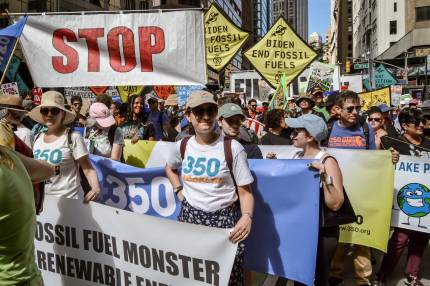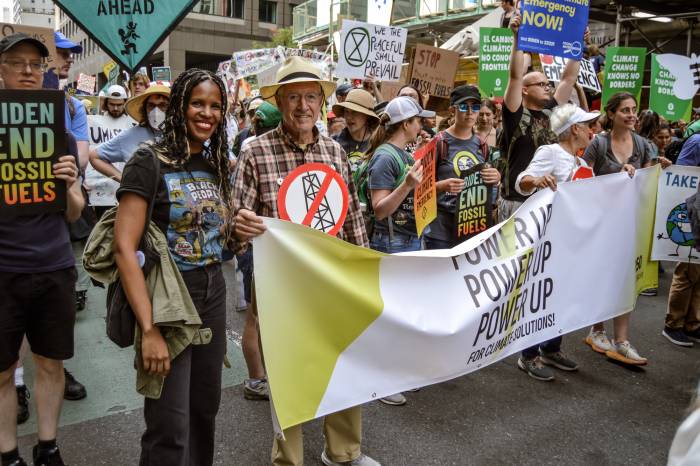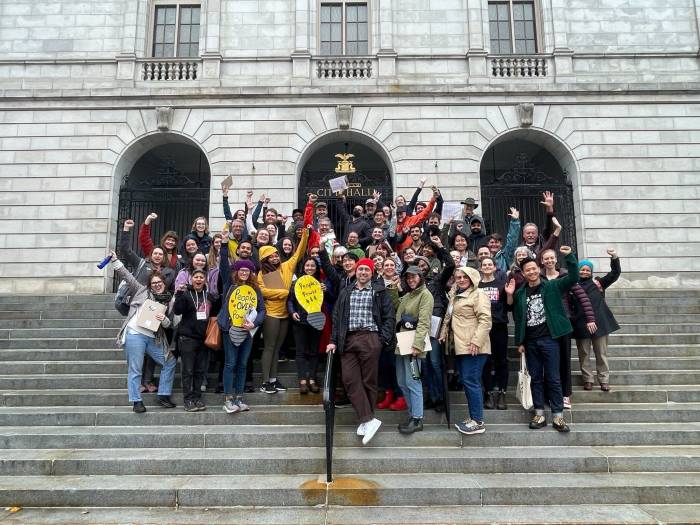
It’s been a mixed year for climate progress in the US. Heading into 2024, we will finally see solar and wind surpass coal production in the US for the first time. 2023 also brought some promising investments in the transition to renewable energy. At the same time, we saw the hottest year on record and intensifying climate disasters that only emphasize the need to fully phase out fossil fuels and transition to justly-sourced, justly-implemented renewable energy much more quickly. The US remains the top oil producer and exporter in the world—it continues to cause disproportionate climate harm without taking adequate responsibility for it.
At the turn of a critical new year, we identified key signs of hope from the US climate movement to carry with us into 2024. All of them reveal growing public awareness of the climate emergency and who is causing it, and a refusal to accept the unjust and unsafe conditions we’ve been expected to accept.

Pictured: members of 350 local groups gather at the March to End Fossil Fuels in NYC
1. Climate week in NYC: the first mass climate march since 2019, direct action, and a pledge for elected officials
Why it matters: this showed coordinated, collective action from across the climate movement. There were meaningful levels of involvement for everyone, including:
- Hundreds risking arrest in disruptive actions at key financial institutions that invest in fossil fuels
- Frontline communities and groups/contingencies from all over the US, including over 1,000 from 350 local groups, marching together in a crowd of 75,000 in NYC, making all the major headlines. Global South forces, including activists from the Ugandan diaspora who have been fighting to #StopEACOP, headed up the march.
- A strategic pledge campaign that over 100 elected officials signed on to. Signees pledged to help hold the Biden admin accountable to phasing out fossil fuels and switching to renewable energy.
- Art and distributed actions across the country and world
2. Over 10,000 people wrote to the Federal Reserve
Why it matters: the Federal Reserve typically exists outside of the public’s attention, as this vague official entity that we can’t influence.
- Many people didn’t know what the Fed does, or why it has a connection to our climate fight.
- But after a year-long campaign for a Fossil Free Federal Reserve, the climate movement helped pressure the Fed, the “referee” of the US economy, to introduce a review of their impact on climate. As we wrapped up the campaign in February, 10,000+ of 350’s members submitted comments on the Federal Reserve’s climate plans.
- Read more: 350 took on the Federal Reserve
3. More Americans believe that climate change is here, now
Why it matters: this growing awareness weakens the fossil fuel industry’s hold on society. And misinformation is one of the biggest tools at their disposal.
- Nearly three-quarters of Americans believe that climate change is causing harm in the US now (Pew Research Center)
- 64% of U.S. adults say both that they’ve recently experienced extreme weather and that they believe it was caused at least partially by climate change, up from 54% in April. (AP News)
- Unfortunately, this also means that frontline communities are facing exacerbating impacts while the rest of the country belatedly wakes up.
- The media is also slowly starting to mention fossil fuels more often in climate change coverage. For example, Arizona news coverage of deadly heatwaves started a headline with “climate change” and named fossil fuels within the article.
- Reminder: many of the major outlets are paid by the fossil fuel industry

Pictured: group photo from the public power convening in Maine in October
4. We saw a renewed and growing push for public power
Why it matters: this growing awareness weakens the fossil fuel industry’s hold on society. And misinformation is one of the biggest tools at their disposal.
- Many view utility companies—and high utility bills—as just a stressful but necessary fact of life. As we increase public awareness of how utilities cater to investors and block renewable energy projects, we weaken the fossil fuel industry’s hold over society.
- Utilities don’t have to be structured this way. Key campaigns, like Pine Tree Power in Maine, showed that across the country there is growing momentum for a different path forward. We can choose public power instead of letting rich faraway investors make our home energy decisions for us.
5. The government is starting to question the planned expansion of LNG (fossil gas), on the heels of COP28
Why it matters: this is an example of our government responding to global public pressure.
- The fossil fuel industry and their backers have historically tried to greenwash gas and present it as a “solution” and an “alternative to fossil fuels.” But gas IS a fossil fuel, and produces methane, which is even more harmful for warming the atmosphere in the short-term than CO2.
- Last week, COP28 concluded with an agreement that is only “historic” considering the extremely low bar past COPs have set. Yet thanks to major pressure from civil society, our partners in the small island nations that face some of the most devastating impact of climate chaos already, and you, COP28 did shift things. The coming year will be a moment of truth for whether top-emitting nations are serious about the “fossil fuel phaseout” that they finally put in the agreement.
- There’s real hope: members of US Congress are now walking back their support of the planned expansion of LNG. Our frontline, environmental and climate justice partners in the Gulf region have long called for this. We’re hopeful that we might actually start to see support for gas wane so the renewable energy we are supporting can actually address the climate crisis.
The post 5 Moments of Hope from the US Climate Movement in 2023 appeared first on 350.


0 Commentaires